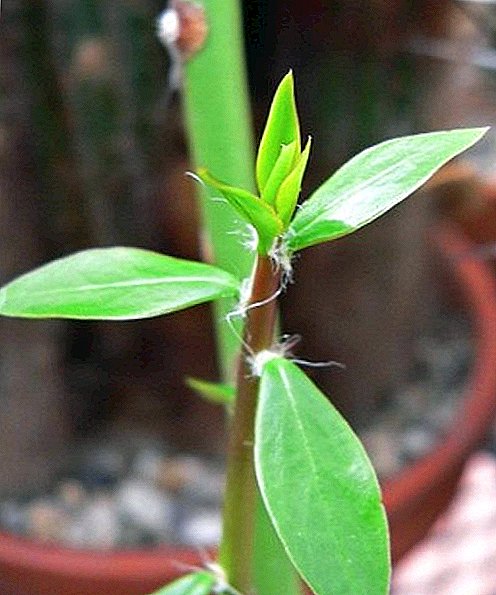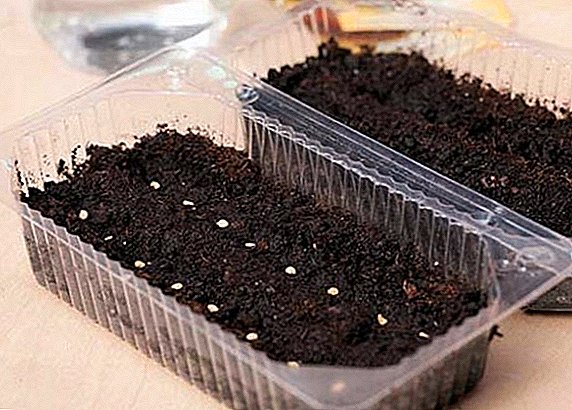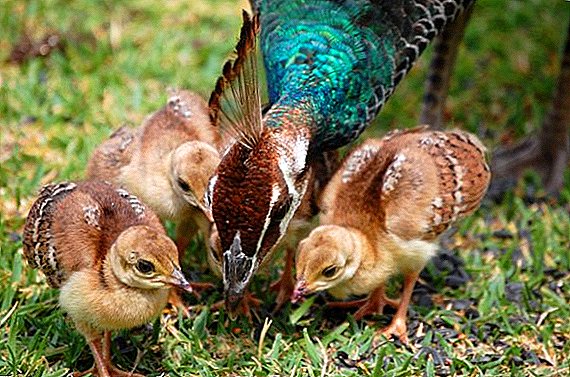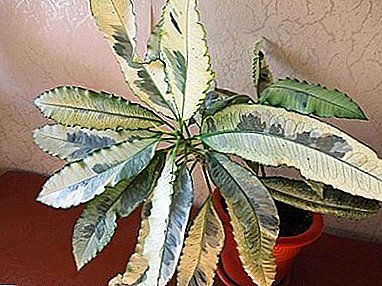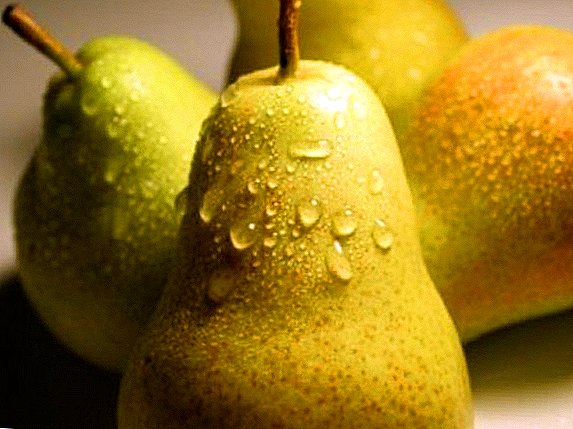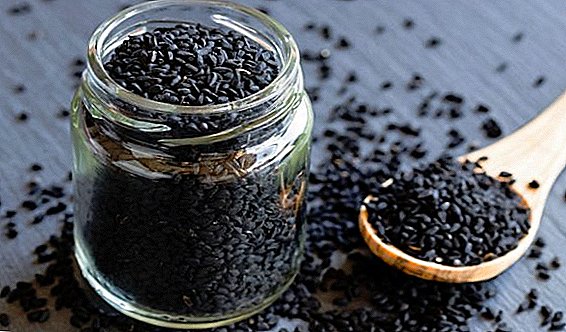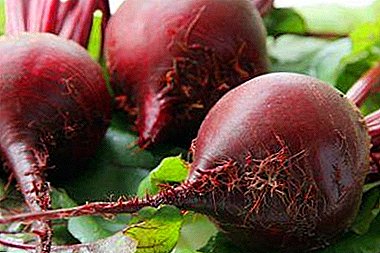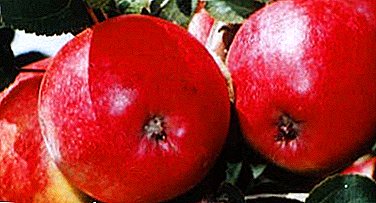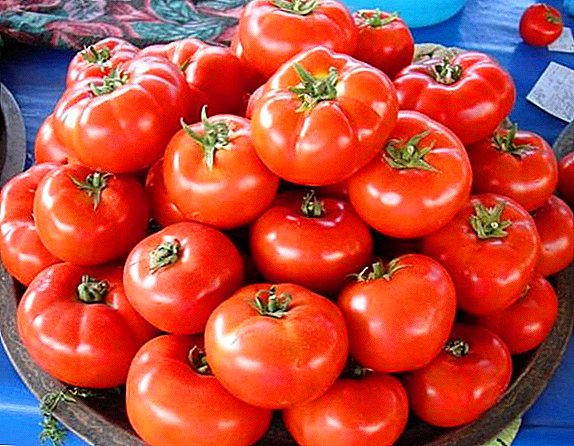 The subject of our conversation in this article will be a variety of tomatoes, which was bred by European experts not so long ago, but has already gained fame as the best among the large-fruited. Its name is "Gina", and this tomato is perfect for growing in open ground, as well as in greenhouses.
The subject of our conversation in this article will be a variety of tomatoes, which was bred by European experts not so long ago, but has already gained fame as the best among the large-fruited. Its name is "Gina", and this tomato is perfect for growing in open ground, as well as in greenhouses.
Did you know? Eating tomatoes is beneficial for humans because they contain carotene, B vitamins (1, 2, 3, 6, 9, 12), C, PP, D, folic acid. Tomatoes are rich in calcium, potassium, manganese, phosphorus, and also contain iron and magnesium.
Variety description
Acquaintance with the variety, we begin with the characteristics of tomatoes "Gina". It refers to mid-season varieties - the fruits ripen on the 120th day after the sprouts appeared.
Fruits grow spherical in shape, slightly ribbed, bright, rich red in color, dense and very large - their average weight is from 150 to 280 g. Record holders reach 300 g. One brush of a bush produces from three to six tomatoes.
It is estimated that a yield of up to 10 kg per square meter is characteristic of the Gina tomato. m  In addition to their excellent yield characteristics, tomatoes of this variety are also gaining popularity due to their excellent taste. Since they are characterized by an excellent combination of sugars and acids - they have a sweet taste with a slight acidity, the fruits are universal in use. Their flesh is juicy and fleshy, contains 4.5-5% dry matter.
In addition to their excellent yield characteristics, tomatoes of this variety are also gaining popularity due to their excellent taste. Since they are characterized by an excellent combination of sugars and acids - they have a sweet taste with a slight acidity, the fruits are universal in use. Their flesh is juicy and fleshy, contains 4.5-5% dry matter.
Tomatoes "Gina" are undersized - the bushes of the plant reach a height of 30-60 cm. They are sown in the middle. From a root grow, as a rule, three stalks. Therefore, tomatoes of this variety do not need to tie up and form a bush in them.
The plant is thermophilic, however, in the southern regions it normally tolerates planting in a seedless way.
It has a hybrid form, which is called "Gina TST". It is distinguished from its predecessor by resistance to cracking, by earlier maturity and smaller fruits. 
Read also about other varieties of tomatoes: "Persimmon", "Siberian early", "Bruin Bear", "Tretyakovsky", "Red Guard", "Bobcat", "Crimson Giant", "Shuttle", "Batyanya".
Pros and cons varieties
If we analyze all the advantages and disadvantages of the "Gin" variety, then its advantages include:
- the possibility of cultivation in open and closed ground;
- good yield;
- large sizes of fruits;
- the duration of fruiting;
- high content of tomatoes in vitamins;
- excellent taste of the fruit;
- good transportability of tomatoes;
- universality of tomatoes;
- compactness and, as a result, the uselessness during cultivation to carry out such procedures as tying, shaping, staving, thinning;
- average weather endurance;
- unpretentious care;
- resistance to such diseases as fusarium, late blight, root rot, verticillis;
- long storage in all weather conditions.

Did you know? When placing Gina tomatoes in sterilized glass containers and a cool dark room, they will retain their appearance and taste for three months.Not so many minuses, among them we note:
- frequent damage by pests;
- poor resistance to temperature fluctuations, which will require a temporary shelter when planted in open ground;
- cracking fruit when ripening.
Read about how to build a polycarbonate greenhouse and a wooden greenhouse for growing tomatoes.
Growing tomatoes through seedlings
Tomatoes can be grown using seedlings and seedless method. Which one to choose depends on the climatic conditions where they are planted. Consider the features of each of them.
Sowing seeds for seedlings
Sow seeds for seedlings should be at the end of March. The last valid date will be the beginning of April. Before sowing, the seeds are placed in a weak solution of potassium permanganate.
After the formation of the first leaves (one or two) sprouts should dive into different tanks with peat.  Periodically, seedlings need to be put outside for hardening. You can start from 15 minutes a day, and then gradually increase this time period.
Periodically, seedlings need to be put outside for hardening. You can start from 15 minutes a day, and then gradually increase this time period.
Planting seedlings on the site
Planted seedlings need in the period from May 25 to June 10. The seedling at the time of planting should be 45-50 days old. In order not to be mistaken with the timing and not to ruin the planting material, it is necessary to inquire about the temperature of the soil.
Important! The soil temperature for planting a tomato should be at least 18 degrees.The recommended planting density is three to four bushes per square meter. m
If the air temperature drops below 17 degrees, the plants must be wrapped.
Is it possible to grow Gina tomatoes in a seedless way?
With a seedless planting method, seeds are sown directly into the ground. This should be done at the same time as planting seedlings: from late spring to early summer.  The seeding procedure is as follows:
The seeding procedure is as follows:
- The formation of grooves 30 cm.
- Soil fertilizer with phosphate-potassium or ash.
- Filling of grooves with earth.
- Abundant watering.
- The formation of shallow holes.
- Laying in them several seeds.
- Powder their land.
How to care for tomatoes "Gina"
After planting in a vegetable garden, “Gina” tomatoes, when grown, behave in the same way as with other tomatoes, however there are some differences: they do not tie up their stems, do not manipulate the formation of bushes and do not stepchildren. Caring for them is standard and consists in watering, loosening the soil and fertilizing. If necessary, you will need to carry out preventive and therapeutic procedures for diseases and harmful insects.
Watering, weeding and loosening the soil
It should be watered when the top layer of soil dries out slightly. During the flowering period, it is recommended to perform this procedure twice a week. In the phase of formation of the fruit, the number of irrigations should be increased and carried out every other day. And in especially hot periods, when the temperature exceeds 28-30 degrees, water daily.  You also need to control the condition of the soil - it should always be loose and clean from weeds. Therefore, tomatoes are shown regular loosening the beds and weeding.
You also need to control the condition of the soil - it should always be loose and clean from weeds. Therefore, tomatoes are shown regular loosening the beds and weeding.
Top dressing bushes
Fertilization is recommended to produce according to the following scheme:
- the first feeding is two weeks after landing in open ground;
- the second feed - after an interval of 10 days;
- the third feeding - two weeks after the previous one;
- fourth dressing - 20 days after the third.
Before each application of fertilizer, tomatoes should be sprinkled with separated or rain water. Feeding and watering procedures should be carried out in the early morning or in the evening, since water or mortar on the leaves is fraught with sunburn.
Important! In order to obtain a better harvest, root dressings are preferably alternated with foliar. After the appearance of the ovaries, fertilization is permitted only at the root.

Resistance to pests and diseases
One of the biggest problems that can comprehend tomatoes is pest infestation. There are plenty of lovers to eat green tomato tops.
Aphid. Often the juice of the plant drinks aphid. As a result, leaves turn yellow and tomatoes become worse. To combat the sucking insects use folk remedies in the form of decoctions of insecticidal plants: onion peel, garlic, tobacco, wormwood. In case of mass lesions, it is necessary to resort to spraying with chemical insecticides: "Decis Pro", "Confidor Maxi", "Ratibor", etc.
Colorado beetle. The larvae of this beetle are also not averse to feast on tomato leaves. For their destruction they use a mechanical method (hand-picking) and a chemical method - spraying with the preparations "Decis Extra", "Senpai", "Confidor", "Corado", etc.  Medvedka. It damages the roots of the plant, causing the plant to fade and may die. Eliminate the pest by treatments "Medvetoksom", "Rembek Granula."
Medvedka. It damages the roots of the plant, causing the plant to fade and may die. Eliminate the pest by treatments "Medvetoksom", "Rembek Granula."
Chafer. The larvae of the cockchafer is also very dangerous for tomatoes, because they can provoke the death of the whole bush. They are fought with insecticides "Basudin", "Zemlin", "Antikhrusch".
Wireworm. The fight against this dangerous insect is carried out by the same means as with the larvae of the May beetle.
To the main diseases inherent in this vegetable crop, Gina is resistant.
Ripening and yield
As a rule, Gina tomatoes ripen within 110-120 days from the appearance of sprouts. The yield of this variety is high: it is possible to collect 2.5-4 kg of tomatoes from one bush. Harvest as tomatoes ripen.
How to use tomatoes "Gina"
When in the advantages of the variety we indicated its versatility, we meant that tomatoes can be eaten fresh, and also they are great for canning and cooking ketchup, adzhika, tomato juice and pasta.
You can also pickle tomatoes for the winter and make tomato jam.Thus, Gina tomatoes have a number of advantages and only a few drawbacks. They are easy to maintain, which allows them to grow even gardeners and gardeners who have no experience. And to make sure of this, here are some reviews from people who have already tried Gina’s own-grown crops:
Elena M .: "It was from this variety that I began to learn how to grow tomatoes. It is really good and fully corresponds to the description."
Lyudmila Y .: “The variety is very good. They are pleased with the time, size and taste. And also its simplicity”.


